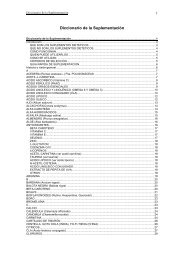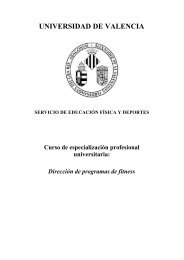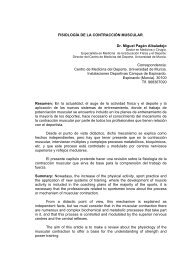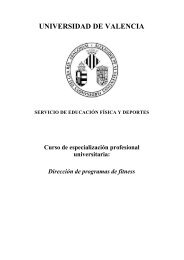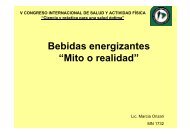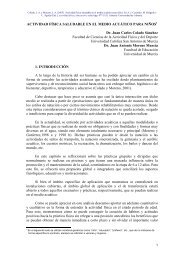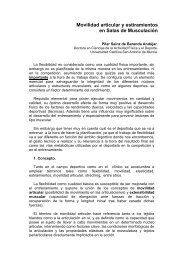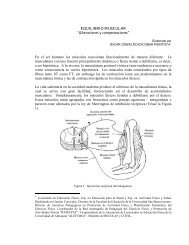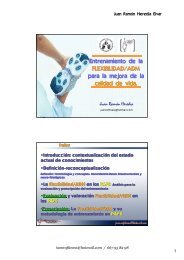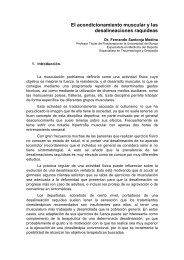Consumer.es ::: Salud y Alimentación - Felipe Isidro Donate
Consumer.es ::: Salud y Alimentación - Felipe Isidro Donate
Consumer.es ::: Salud y Alimentación - Felipe Isidro Donate
You also want an ePaper? Increase the reach of your titles
YUMPU automatically turns print PDFs into web optimized ePapers that Google loves.
Nutrient Data Laboratory - Frequently Asked Qu<strong>es</strong>tions<br />
What are omega-3 and omega-6 fatty acids?<br />
Th<strong>es</strong>e are typ<strong>es</strong> of polyunsaturated fatty acids. Linolenic acid, the short<strong>es</strong>t chain omega-3 fatty acid, and linoleic acid, the short<strong>es</strong>t<br />
chain omega-6 fatty acid, are <strong>es</strong>sential fatty acids. This means they cannot be synth<strong>es</strong>ized by the body from other fatty acids and must<br />
be obtained from food. The most common fatty acids of each class are linolenic (18:3), EPA (20:5), DHA (22:6) for omega-3 and<br />
linoleic (18:2) and arachidonic (20:4) for omega-6. Some of the food sourc<strong>es</strong> of omega-3 fatty acids are fish and shellfish, flaxseed,<br />
walnuts, and canola oil. A computer software package, KIM (Keep it Managed) can be downloaded from<br />
http://ods.od.nih.gov/eicosanoids. This software evaluat<strong>es</strong> the balance of omega-3 and omega-6 fatty acids in your diet. A scientific<br />
discussion of physiological effects of omega-3 fatty acids can be found on the American Heart Association Web site.<br />
Where do I get information on nutrition labeling?<br />
USDA's Food Safety and Inspection Service (FSIS) regulat<strong>es</strong> the labeling of meat and poultry. The Food and Drug Administration<br />
(FDA) is r<strong>es</strong>ponsible for all other foods. Information on labeling is available from FDA's Home Page, or in a more consumer oriented<br />
Q&A section, or by e-mail.<br />
Back to Top<br />
Where can I get information about the Child Nutrition Database (CN)?<br />
The Child Nutrition Database (CN), previously referred to as the National Nutrient Database for Child Nutrition Programs<br />
(NNDCNP), serv<strong>es</strong> the National School Lunch and Breakfast programs as part of the School Meals Initiative for Healthy Children.<br />
Additional information on the CN database and a comparison of the SR and the CN Database is available.<br />
Back to Top<br />
My son/daughter has a science fair project. How do<strong>es</strong> he/she analyze a food for a<br />
particular nutrient?<br />
Methods for determination of nutrients in foods are published in the "Official Methods of Analysis of AOAC International," The 16th<br />
edition com<strong>es</strong> in 2 volum<strong>es</strong>. If only earlier editions of the publication can be found, some methods such as the titrimetric method for<br />
vitamin C, have not changed in many years. There are also other publications which your child's science teacher can recommend.<br />
Caution: Many methods of analysis for foods require the use of strong chemicals, use of specialized equipment and adult supervision.<br />
Age and experience of the student should be considered when experiments are planned. Younger students may be encouraged to<br />
conduct simple experiments which are planned with the teacher's or parent's guidance.<br />
Back to Top<br />
Do you have r<strong>es</strong>ourc<strong>es</strong> for teachers?<br />
ARS's Information Staff has prepared "Science 4 Kids." which is a seri<strong>es</strong> of stori<strong>es</strong> about what scientists do here at the ARS. They<br />
have also prepared the "Whiz Kid" Activity Packet, which is intended for teachers, and is chock-full of fun and clever graphics to<br />
introduce agricultural r<strong>es</strong>earch topics.<br />
Back to Top<br />
Last modified: August 15, 2002<br />
http://www.nal.usda.gov/fnic/foodcomp/Bulletins/faq.html (4 de 4) [05/01/2003 12:19:37 p.m.]



